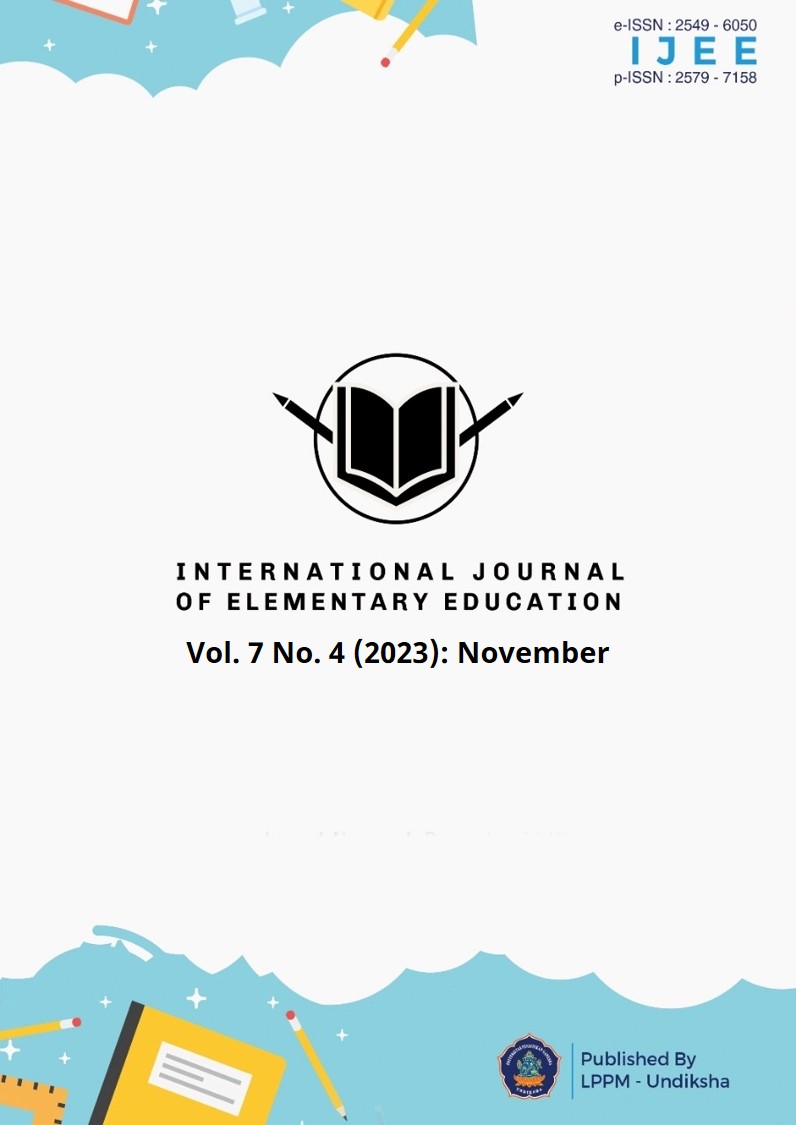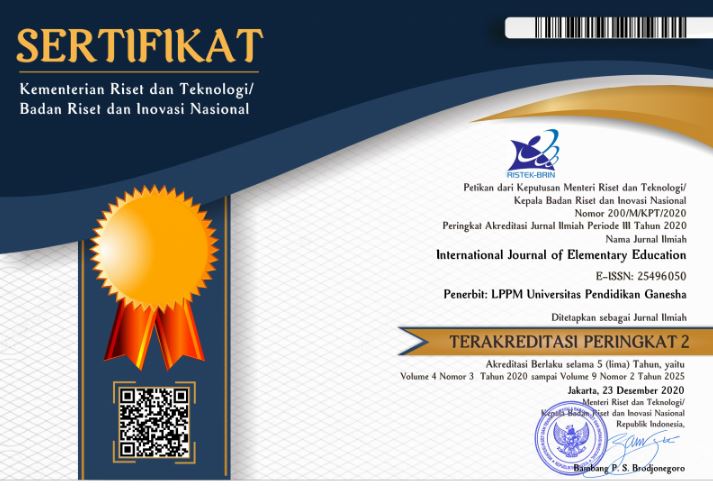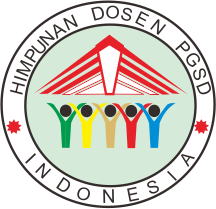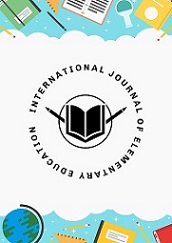The Reactualization of Sipakatau, Sipakalebbi, and Sipakainge’ Values Using La Galigo Comic with Augmented Reality
DOI:
https://doi.org/10.23887/ijee.v7i4.59779Keywords:
Augmented Reality, Comic, Elementary School, La Galigo, TrisipakaAbstract
Base on observation there is no educative and interactive learning media in local content lessons related to strengthening student character. This study aims to analyze student interest and enthusiasm in local content lessons, understand the values, diversity, and inclusivity contained in La Galigo through Augmented Reality (AR)-based comic. This study is use Wilcoxon signed-rank test is used to compare the pre-test and post-test, also comparing anecdotal notes of student activities. A total of 14 students from the 4th and 5th grade participated in this program. Data collection is use observations, anecdotal records, and in-depth interviews were also used to assess students' personalities. Based on the evaluation of the pre-test and post-test, there is an increase in students' knowledge after the comic learning method is used. Changes in student’s knowledge and attitude are accomplished through the use of continuous assessment indicators and the involvement of the teacher in the classroom. It is hoped that this innovation can help students develop better character by incorporating trisipaka-based values (sipakatau, sipakalebbi, and sipakainge') into their daily lives.
References
Adams, J. D., & Mabusela, M. S. (2014). Assessing with Role Play: An Innovation in Assessment Practice. J Soc Sci, 41(3), 363–374. https://doi.org/10.1080/09718923.2014.11893371. DOI: https://doi.org/10.1080/09718923.2014.11893371
Alawamleh, M., Al-Twait, L. M., & Al-Saht, G. R. (2022). The effect of online learning on communication between instructors and students during Covid-19 pandemic. Asian Education and Development Studies, 11(2), 380–400. https://doi.org/10.1108/AEDS-06-2020-0131. DOI: https://doi.org/10.1108/AEDS-06-2020-0131
Alit, K., Adnyani, D., Wibawa, I. M. C., & Margunayasa, I. G. (2021). Alternative Energy Sources on Digital Comic Media. International Journal of Elementary Education, 5(1), 61–70. https://doi.org/10.23887/ijee.v5i1.34333. DOI: https://doi.org/10.23887/ijee.v5i1.34333
Andini, D. A., & Kurniaman, O. (2021). Comic Media to Improve Speaking Skill of the Fourth Grade Students. International Journal of Elementary Education, 6(3), 585–592. https://doi.org/10.23887/ijee.v6i4.55510.
Andriani, M. W., & Ramadani, A. (2022). Pengaruh Penggunaan Media Augmented Reality Berbasis Android Terhadap Kemampuan Berpikir Kritis Siswa Kelas Sekolah Dasar. JUPE, 7(2), 567–576. https://doi.org/10.58258/jupe.v7i2.3849. DOI: https://doi.org/10.58258/jupe.v7i2.3849
Apriati, L., Mulawarman, W. G., & Ilyas, M. (2021). Pengembangan Bahan Ajar Menyimak Berbasis Multimedia Interaktif pada Pelajaran Tematik dengan Tema “Indahnya Kebersamaan” untuk Siswa Kelas IV Sekolah Dasar. Diglosia: Jurnal Kajian Bahasa, Sastra, Dan Pengajarannya, 4(1), 13–22. https://doi.org/10.30872/diglosia.v4i1.73. DOI: https://doi.org/10.30872/diglosia.v4i1.73
Asfar, A. M. I. T., Asfar, A. M. I. A., & Nurannisa, A. (2021). Integration of Local Traditions Bugis-Makassarese: Learning Strategies to Improve Mathematical Communication Skills. IOP Conference Series: Earth and Environmental Science, 1808(1). https://doi.org/10.1088/1742-6596/1808/1/012064. DOI: https://doi.org/10.1088/1742-6596/1808/1/012064
Bumbungan, B., Bafadal, I., Ulfatin, N., & Supriyanto, A. (2022). School Principal’s Wanua Mappatuo Naewai Alena Leadership: A Strategy to Develop School Entrepreneurship. Pegem Egitim ve Ogretim Dergisi, 13(1), 309–318. https://doi.org/10.47750/pegegog.13.01.34. DOI: https://doi.org/10.47750/pegegog.13.01.34
Cress, U., Rosé, C. P., Law, N., & Ludvigsen, S. (2019). Investigating the complexity of computer-supported collaborative learning in action. International Journal of Computer Supported Collaborative Learning, 14(2), 137–142,. https://doi.org/10.1007/s11412-019-09305-2. DOI: https://doi.org/10.1007/s11412-019-09305-2
Creswell, J. W., & Creswell, J. D. (2018). Research design qualitative, quantitative, and mixed methods approaches. In SAGE Publication, Incs (5th ed.). SAGE Publications, Inc.
Darmayanti, R., Sugianto, R., Baiduri, C., & Wawan. (2022). Digital comic learning media based on character values on students’ critical thinking in solving mathematical problems in terms of learning styles. Al Jabar: Jurnal Pendidikan Matematika, 13(1), 49–66. http://ejournal.radenintan.ac.id/index.php/al-jabar/index. DOI: https://doi.org/10.24042/ajpm.v13i1.11680
Febriansyah, D., Dwiputra, K., Budiyanto, T. M., & Adz, T. (2020). Textbooks Transformation Into Digital Comics As Innovative Learning Media for Social Science Studies in Junior High School. International Journal Pedagogy of Social Studies, 5(2), 9–16. https://doi.org/10.17509/ijposs.v5i2.29068.
Fitria, T. N. (2023). Augmented Reality (AR) and Virtual Reality (VR) Technology in Education: Media of Teaching and Learning: A Review Penerapan Teknologi Informasi Dalam Pembelajaran: Web-Based Learning Dan Mobile-Based Learning View project Error Analysis of Students’ Writi. International Journal of Computer and Information System (IJCIS) Peer Reviewed-International Journal, 4(1), 2745–9659. https://doi.org/10.29040/ijcis.v4i1.102.
Fitria, T. N., Simbolon, N. E., & Afdaleni. (2022). Possibility of Metaverse in Education: Opportunity and Threat. SOSMANIORA (Jurnal Ilmu Sosial Dan Humaniora, 1(3), 365–375. https://doi.org/10.55123/sosmaniora. DOI: https://doi.org/10.55123/sosmaniora
Garzón, J., Pavón, J., & Baldiris, S. (2019). Systematic review and meta-analysis of augmented reality in educational settings. Virtual Reality, 23(4), 447–459. https://doi.org/10.1007/s10055-019-00379-9. DOI: https://doi.org/10.1007/s10055-019-00379-9
Gendolang, N. D. A. (2022). Religiusitas Budaya" Sipakatau, Sipakalebbi, Sipakainge" Masyarakat Kristen di Tanah Bugis Watansoppeng, Sulawesi Selatan: Perspektif Resiliensi Sosial. DOI: https://doi.org/10.34007/jehss.v5i3.1542
Gumilang, M. R., Wahyudi, W., & Indarini, E. (2019). Pengembangan Media Komik dengan Model Problem Posing untuk Meningkatkan Kemampuan Pemecahan Masalah Matematika. Journal of Medives : Journal of Mathematics Education IKIP Veteran Semarang, 3(2), 185. https://doi.org/10.31331/medivesveteran.v3i2.860. DOI: https://doi.org/10.31331/medivesveteran.v3i2.860
Halili, S. H. (2019). Technological Advancements in Education 4.0. The Online Journal of Distance Education and E-Learning, 7(1), 63–69. https://tojdel.net/journals/tojdel/volumes/tojdel-volume07-i01.pdf#page=70.
Halima, A., Khumas, A., & Zainuddin, K. (2021). Sipakatau, Sipakainge, Sipakalebbi: Sebuah Nilai Budaya untuk Upaya Pencegahan Bullying dengan Memaksimalkan Peran Bystander. Indonesian Psychological Research, 3(2), 82–90. https://doi.org/10.29080/ipr.v3i2.549. DOI: https://doi.org/10.29080/ipr.v3i2.549
Hardiyanti, W. E., Ilham, M., Ekadayanti, W., & Jafarudin, J. (2020). Pelatihan Pembuatan Video Animasi Gambar “Powtoon” bagi Guru PAUD. Abdimas Pedagogi: Jurnal Ilmiah Pengabdian Kepada Masyarakat, 3(2), 78. https://doi.org/10.17977/um050v3i2p78-86. DOI: https://doi.org/10.17977/um050v3i2p78-86
İlhan, A. (2021). The Impact of Game-Based, Modeling, and Collaborative Learning Methods on the Achievements, Motivations, and Visual Mathematical Literacy Perceptions. SAGE Open, 11(1). https://doi.org/10.1177/21582440211003567. DOI: https://doi.org/10.1177/21582440211003567
Jamaluddin, A. Bin, Zubaidah, S., Mahanal, S., & Gofur, A. (2022). Exploration of the Indonesian Makassar-Buginese Siri’ educational values: The foundation of character education. International Journal of Evaluation and Research in Education, 11(1), 10–19. https://doi.org/10.11591/ijere.v11i1.21670. DOI: https://doi.org/10.11591/ijere.v11i1.21670
Karo-Karo, I. R., & Rohani, R. (2018). Manfaat Media dalam Pembelajaran. AXIOM : Jurnal Pendidikan Dan Matematika, 7(1), 91–96. https://doi.org/10.30821/axiom.v7i1.1778. DOI: https://doi.org/10.30821/axiom.v7i1.1778
Khotimah, H., & Hidayat, N. (2022). Interactive Digital Comic Teaching Materials to Increase Student Engagement and Learning Outcomes. International Journal of Elementary Education, 6(2), 245–258. https://doi.org/10.23887/ijee.v6i2.
Koparan, T., Dinar, H., Koparan, E. T., & Haldan, Z. S. (2023). Integrating augmented reality into mathematics teaching and learning and examining its effectiveness. Thinking Skills and Creativity, 47, 101245. https://doi.org/10.1016/J.TSC.2023.101245. DOI: https://doi.org/10.1016/j.tsc.2023.101245
Kurniawan, Y. I., Fajar, A., & Kusuma, S. (2021). Aplikasi Augmented Reality untuk Pembelajaran Salat bagi Siswa Sekolah Dasar. Jurnal Teknologi Informasi Dan Ilmu Komputer. Jurnal Teknologi Informasi Dan Ilmu Komputer, 8(1), 7–14. https://doi.org/10.25126/jtiik.202182182. DOI: https://doi.org/10.25126/jtiik.2020712182
Kusuma, F. E. E., Setyawan, M. B., & Zulkarnain, I. A. (2019). Penerapan Teknologi Augmented Reality Berbasis Android Sebagai Media Pembelajaran Pengenalan Aksara Jawa di SDN 1 Sidorejo Ponorogo. KOMPUTEK: Jurnal Mahasiswa Universitas Muhammadiyah Ponorogo, 3(1), 61–67. https://doi.org/10.58258/jupe.v7i2.3849. DOI: https://doi.org/10.24269/jkt.v3i1.203
Kysela, J., & Štorková, P. (2015). Using Augmented Reality as a Medium for Teaching History and Tourism. Procedia - Social and Behavioral Sciences, 174, 926–931. https://doi.org/10.1016/j.sbspro.2015.01.713. DOI: https://doi.org/10.1016/j.sbspro.2015.01.713
Lusiyani, R., & Dara Anindya, W. (2021). Choosing and Using Learning Media during Remote Teaching: Teachers’ Thought. Journal of English Language Teaching and Linguistics) e-ISSN, 6(2), 2021. https://doi.org/10.21462/jeltl.v6i2.555. DOI: https://doi.org/10.21462/jeltl.v6i2.555
Mustoip, S., Japar, M., & MS, Z. (2018). Implementasi Pendidikan Karakter. CV. Jakad Publishing. DOI: https://doi.org/10.31227/osf.io/qft7g
Ningrum, K. D., Utomo, E., Marini, A., & Setiawan, B. (2022). Media Komik Elektronik Terintegrasi Augmented Reality dalam Pembelajaran Sistem Peredaran Darah Manusia di Sekolah Dasar. Jurnal Basicedu, 6(1), 1297–1310. https://doi.org/10.31004/basicedu.v6i1.2289. DOI: https://doi.org/10.31004/basicedu.v6i1.2289
Oktari, D. P., & Kosasih, A. (2019). Pendidikan Karakter Religius dan Mandiri di Pesantren. Jurnal Pendidikan Ilmu Sosial, 28(1), 42. https://doi.org/10.17509/jpis.v28i1.14985. DOI: https://doi.org/10.17509/jpis.v28i1.14985
Pathuddin, H., Kamariah, K., & Nawawi, M. I. (2021). Buginese Ethnomathematics: Barongko Cake Explorations as Mathematics Learning Resources. Journal on Mathematics Education, 12(2), 295–312. https://doi.org/10.22342/jme.12.2.12695.295-312. DOI: https://doi.org/10.22342/jme.12.2.12695.295-312
Putri, R. S., Purwanto, A., Pramono, R., Asbari, M., Wijayanti, L. M., & Hyun, C. ch. (2020). Impact of the COVID-19 Pandemic on Online Home Learning: An Explorative Study of Primary Schools in Indonesia. International Journal of Advanced Science and Technolog, 29(5), 4809–4818. https://www.researchgate.net/publication/341194197.
Rashid, S., & Qaisar, S. (2017). Role Play: A Productive Teaching Strategy to Promote Critical Thinking. Bulletin of Education and Research, 39(2), 197–213. https://eric.ed.gov/?id=EJ1210125.
Restika, P. A., Nirwana, H., & Asriyadi. (2021). Implementasi Augmented RealitySebagai Media Pembelajaran untuk Pengenalan Komponen Total Station. Prosiding Seminar Nasional Teknik Elektro Dan Informatika (SNTEI, 208–214. https://images.app.goo.gl/V6awh6uexizqL1G29.
Rina, N., Suminar, J. R., Damayani, N. A., & Hafiar, H. (2020). Character education based on digital comic media. International Journal of Interactive Mobile Technologies, 14(3), 107–127. https://doi.org/10.3991/ijim.v14i03.12111. DOI: https://doi.org/10.3991/ijim.v14i03.12111
Rochmawati, F., Suryanti, S., & Sudibyo, E. (2021). Pengembangan Perangkat Bimbingan melalui Bermain Peran (Role Playing) dan Terapi Bioskop Sains (Sciencecinematherapy) untuk Meningkatkan Empati Siswa SD. PENDIPA Journal of Science Education, 6(1), 201–208. https://doi.org/10.33369/pendipa.6.1.201-208. DOI: https://doi.org/10.33369/pendipa.6.1.201-208
Rønning, S. B., & Bjørkly, S. (2019). The use of clinical role-play and reflection in learning therapeutic communication skills in mental health education: An integrative review. Advances in Medical Education and Practice, 10, 415–425. https://doi.org/10.2147/AMEP.S202115. DOI: https://doi.org/10.2147/AMEP.S202115
Rosyida, A., & Subroto, W. T. (2018). The Development of Contextual Teaching and Learning-Based Comic as a Learning Media for Ele-mentary School Students. Advances in Social Science, Education and Humanities Research, 173(2), 13–16. https://doi.org/10.2991/icei-17.2018.4. DOI: https://doi.org/10.2991/icei-17.2018.4
Samerkhanova, E. K., & Imzharova, Z. U. (2018). Organizational and pedagogical conditions for forming the readiness of future teachers for project activities in the context of Digitalization of education. Vestnik of Minin University, 6(2). https://doi.org/10.26795/2307-1281-2018-6-2-2. DOI: https://doi.org/10.26795/2307-1281-2018-6-2-2
Saputri, D. Y., Rukayah, R., & Indriayu, M. (2018). Need Assessment of Interactive Multimedia Based on Game in Elementary School: A Challenge into Learning in 21st Century. International Journal of Educational Research Review, 3(3), 1–8. https://doi.org/10.24331/ijere.411329. DOI: https://doi.org/10.24331/ijere.411329
Saputro, R. E., & Saputra, D. I. S. (2015). Pengembangan Media Pembelajaran Mengenal Organ Pencernaan Manusia Menggunakan Teknologi Augmented Reality. Jurnal Buana Informatika, 6(2), 153–162. https://doi.org/10.24002/jbi.v6i2.404. DOI: https://doi.org/10.24002/jbi.v6i2.404
Shaumiwaty, S., Fatmawati, E., Sari, H. N., Vanda, Y., & Herman, H. (2022). Implementation of Augmented Reality (AR) as A Teaching Media in English Language Learning in Elementary School. Jurnal Obsesi : Jurnal Pendidikan Anak Usia Dini, 6(6), 6332–6339. https://doi.org/10.31004/obsesi.v6i6.3398. DOI: https://doi.org/10.31004/obsesi.v6i6.3398
Shernoff, D. J., Ruzek, E. A., & Sinha, S. (2017). The influence of the high school classroom environment on learning as mediated by student engagement. School Psychology International, 38(2), 201–218. https://doi.org/10.1177/0143034316666413. DOI: https://doi.org/10.1177/0143034316666413
Silva, M., Bermúdez, K., & Caro, K. (2023). Effect of an augmented reality app on academic achievement, motivation, and technology acceptance of university students of a chemistry course. Computers & Education: X Reality, 2, 100022. https://doi.org/10.1016/j.cexr.2023.100022. DOI: https://doi.org/10.1016/j.cexr.2023.100022
Siregar, R. A. (2020). The Effective 21st-century Pedagogical Competence as Perceived by Pre-service English Teachers. Pedagogy : Journal of English Language Teaching, 8(1), 1. https://doi.org/10.32332/pedagogy.v8i1.1953. DOI: https://doi.org/10.32332/pedagogy.v8i1.1953
Spante, M., Hashemi, S. S., Lundin, M., & Algers, A. (2018). Digital competence and digital literacy in higher education research: Systematic review of concept use. Cogent Education, 5(1), 1519143. https://doi.org/10.1080/2331186X.2018.1519143. DOI: https://doi.org/10.1080/2331186X.2018.1519143
Süt, H. M., & Öznaçar, B. (2017). International Journal of Curriculum and Instruction Effects of COVID-19 period on educational systems and institutions conditions of the Creative Commons Attribution license (CC BY-NC-ND. International Journal of Curriculum and Instruction, 13(1), 537–551. https://ijci.globets.org/index.php/IJCI/article/view/554.
Tiarasari, A. T., Sukarno, S., & Sarwanto, S. (2018). Interactive Multimedia Use To Increase Learning Interest. Social, Humanities, and Educational Studies (SHEs): Conference Series, 1(1), 38–47. https://doi.org/10.20961/shes.v1i1.23540. DOI: https://doi.org/10.20961/shes.v1i1.23540
Toa, R. (2017). La Galigo Menurut Naskah NBG 188 (1st ed.). Yayasan Pustaka Obor.
Toh, T. L., Cheng, L. P., Ho, S. Y., Jiang, H., & Lim, K. M. (2017). Use of comics to enhance students’ learning for the development of the twenty-first century competencies in the mathematics classroom. Asia Pacific Journal of Education, 37(4), 437–452. https://doi.org/10.1080/02188791.2017.1339344. DOI: https://doi.org/10.1080/02188791.2017.1339344
Wedyan, M., Falah, J., Elshaweesh, O., Alfalah, S. F. M., & Alazab, M. (2022). Augmented Reality-Based English Language Learning: Importance and State of the Art. Electronics (Switzerland, 11(17). https://doi.org/10.3390/electronics11172692. DOI: https://doi.org/10.3390/electronics11172692
Yamin, M., Kurnia, F. D., & Mustofa, A. (2020). Language Power in the Classroom Viewed from Nietzsche and Heidegger. OKARA: Jurnal Bahasa Dan Sastra, 14(1), 117. https://doi.org/10.19105/ojbs.v14i1.2683. DOI: https://doi.org/10.19105/ojbs.v14i1.2683
Yapici, İ. Ü., & Karakoyun, F. (2021). Using Augmented Reality In Biology Teaching. Malaysian Online Journal of Educational Technology, 9(3), 40–51. https://doi.org/10.52380/mojet.2021.9.3.286. DOI: https://doi.org/10.52380/mojet.2021.9.3.286
Yusof, N., & Alas, Y. (2021). Benefits and Students’ Perception on Role-Play Teaching Technique: Progressive & Fun Learning Experiences in Brunei. Indonesian Journal on Learning and Advanced Education (IJOLAE, 3(3), 225–234. https://doi.org/10.23917/ijolae.v3i3.12364. DOI: https://doi.org/10.23917/ijolae.v3i3.12364
Ziatdinov, R., & Cilliers, J. (2021). Generation Alpha: Understanding the Next Cohort of University Students. European Journal of Contemporary Education, 10(3), 783–789. https://profiles.uts.edu.au/Jua.Cilliers. DOI: https://doi.org/10.13187/ejced.2021.3.783
Downloads
Published
How to Cite
Issue
Section
License
Copyright (c) 2023 Shinta Dewi Sugiharti Tikson, Samintang -, Firdaus, Andi Khaerun Nisa, Wahda, Fahrina Mustafa

This work is licensed under a Creative Commons Attribution-ShareAlike 4.0 International License.
Authors who publish with the International Journal of Elementary Education agree to the following terms:
- Authors retain copyright and grant the journal the right of first publication with the work simultaneously licensed under a Creative Commons Attribution License (CC BY-SA 4.0) that allows others to share the work with an acknowledgment of the work's authorship and initial publication in this journal.
- Authors are able to enter into separate, additional contractual arrangements for the non-exclusive distribution of the journal's published version of the work (e.g., post it to an institutional repository or publish it in a book), with an acknowledgment of its initial publication in this journal.
- Authors are permitted and encouraged to post their work online (e.g., in institutional repositories or on their website) prior to and during the submission process, as it can lead to productive exchanges, as well as earlier and greater citation of published work. (See The Effect of Open Access)










